
If you can still see two, you have better acuity than I do. You also have a bigger house.
- Without my glasses, I can barely see one. Acuity, not perceptual issues, is the major problem for me here.
- Screening tests for acuity are typically provided in the schools, although probably not frequently enough. A regime of regular check-ups with an optometrist or an ophthalmologist for both children and adults is a wise practice.
Accommodation is the ability to focus on objects at various distances.
- Accommodation: This is the ability to focus on objects at various distances. Newborn infants can only focus out to about nine inches.
- Hence, if dad is peering through the window at baby in the nursery right after delivery, (hopefully baby would have been able to stay with the mom, of course), the smile he may see would be more likely due to a state of intestinal gas rather than visual recognition.
- Within days, however, the child's accommodation becomes fully functional--but not for everybody.
- Some children even by school age have problems in switching focus. Although they can do it, it takes an inordinately long time to complete the process.
- This near/far focusing difficulty creates problems in school when children try to copy information from the blackboard.
Changing focus may be a problem for some children.
- It also relates to eye comfort when viewing an object from a distance. There is an interesting comment on that in the Notes below.
- I experienced a similar problem, to my surprise, when I tried to instruct my sons in the proper use of fire arms (in this case a beebee gun).
- Although I had never had problems with near/far focusing, this was one of those little surprises that crop-up with the aging process.
- I could see the bead on the end of the gun barrel clearly, but when I switched to look at the target, it took so long to focus on the target that I lost all sight and control of the gun barrel direction. And when I switched back to the gun barrel, it took so long to focus on it that Iost sight of the direction of the target.
Following a line of direction with the eyes may be a problem for some children.
- I never could resolve the two so I switched to teaching my sons chess, which I could handle visually if not mentally.
- For a teacher in a classroom, I think it would be an interesting activity to test the students' ability to focus between the blackboard and their desks.
- For example, a bingo type game might be adapted for this purpose. Students could match a number put on the board with a card on the desk.
- The teachers could time their responses and perhaps detect a potential problem here and there.
- Tracking: This is the ability of the eyes to follow a line of movement. Actually, there are two considerations here. Can the eyes track a moving object; and can they do it together.
- A somewhat quick, if not highly sensitive, screening test can be conducted in the classroom.
If thy eyes do not move together, the child may get a double overlapping image.
- Put a colored tack in the eraser of a pencil and ask the child to follow it with his/her eyes as you move the pencil in a horizontal or vertical line across his field of vision.
- The child must follow the movement of the tack with the eyes, of course, and not by turning his head. If the eyes fail to follow or follow with intermittent breaks, a tracking problem may be indicated.
- Another thing to note in this activity, is whether or not the eyes move together. If they do not coordinate, the visual field may actually be splitting into two overlapping images.
- This could wreak havoc when a child is attempting to learn to read. Each word may split into two overlapping words every time the child's eyes move. The child would not necessarily complain because he might assume everyone sees that way.
Children are born with the capacity to perceive changes in brightness as well as adults.
- Sadly the child himself and the adults around him, may misinterpret his failure to acquire reading as an indication of low intelligence rather than to an eye problem.
- Visual Perceptual Skills: In terms of visual perceptual processes, the skills I have chosen to discuss are: 1. Brightness Discrimination; 2. Pattern preference; 3. Depth Perception; 4. Size and Shape Constancy; 5. Position in Space, and Spatial Relations; and 6. Pattern Recognition.
- 1. Brightness Discrimination: There are three startling things about brightness discrimination in infants. One, is that infants can discriminate minute changes in brightness as well as adults. The second is that they (the researchers) can discover this.
Illustration of Brightness Discrimination by infants (below)--not to be taken as scientific demonstration
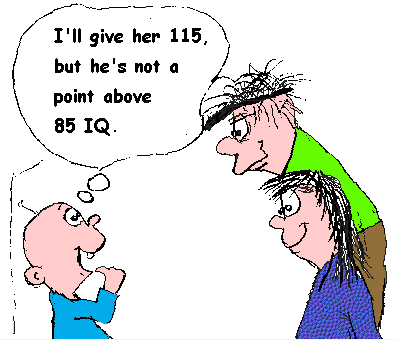
What can you expect, considering this is a Class II University.
Infants are neurologically wired to seek out patterns in their visual field.
- How do they do that? Imagine trying explain to an infant to raise his finger when he thinks the room gets brighter.
- Of course they don't do it that way. What they do is to wire the infant's pacifier to register a change in sucking behavior. This change occurs automatically when the child perceives a change in his environment, in this case brightness.
- The third is that anyone would consider this information worth talking about. And yet it is important, because it sets the stage for the next perceptual process...Pattern Preference.
- 2. Pattern Preference: If an infant is gazing at an opaque surface, and some kind of pattern is introduced into his visual field, the child is "wired" neurologically to seek the pattern out and fixate on it. It can be demonstrated that, although the pattern may have no meaning, the child is processing the image.
- When an infant fixates on a pattern, there are changes in his brain wave activity, and there is an increase in the blood flow to the areas of the brain involved in the stimulation.
- There are several beneficial consequences to all of this. First of all, patterns are the source of all information for the mind. Hence, this is the beginning of the development of concepts, which is half the battle in language acquisition.
- The more patterns the child experiences, the more information the mind will have to work with.
- But, equally important is the impact that the stimulation has upon neural growth! We have already noted that neural activity is a major contributor to the neural growth process. More neural activity means more growth. In addition an increase in blood flow to thoswe stimulated areas means a greater supply of oxygen, protiens and other important nutrients for growth.
The most powerful pattern for infant stimulation is the human face when it is speaking.
- This is where Brightness Discrimination comes into play. Patterns are nothing but organized patches of differences in brightness. Hence, Brightness Discrimination is the major tool for the perception of patterns--and children are born ready to use it!
- Those early days (weeks and months and years) when the brain is growing at such a fast rate, are the windows of opportunity to facilitate that growth as much as possible.
- And, pattern stimulation is the name of the game. The beauty of it all is that it doesn't cost much! A welfare mother can do as much for her child as a millionairess.
- It does, however, require time and commitment. The big gun, for example, is the human face (hopefully mom's or dad's).
- Most highly prized by children are three dimensional patterns, rather than two. And the most powerful pattern among those is one that is speaking!
Moms and Dads are the number one source of brain growth for the infant if, only they will pick their babies up and talk to them a lot.
- Happily, most families can afford a human face. So all that is left to do is to pick the child up frequently during the day (and night as needed) and talk to him/her a lot. If you are not sure about it, error on the high side of frequently and a lot.
- Some parents (baby sitters and/or day care professionals) are overjoyed when a baby spends long hours in a crib without complaining.
- That frees time to watch TV, do house cleaning, or attend to other children who are complaining.
- But for the "quiet" child, irretrievable windows (minutes) of opportunity for neural growth may be slipping away for ever. We have seen how in the first six months brain growth can be measured in milligrams per minute.
- We have seen how children deprived of stimulation (touch) alone have less brain tissue than those that are touched.
Professional infant care centers may not be able to provide the intensity of stimulation that parents will give to their babies.
- We know that the child is ready to perceive visual patters and actually prefers them. From minute one, then, the goal is to pick up and hold (carry) the infant as frequently as possible, and in doing so provide him/her with that 3D view of their favorite pattern--a face!
- Unless one is deaf, it is also very beneficial to talk to the child a lot while doing it. Deaf parents should sign to their babies but only hopefully after they have put them down!
Only parents and relatives are typically motivated enough to do all this to the extent that I would like to see.
- For them it is a labor of love. For others it is labor, and the focus is often on labor relations rather than on what is best for the child.
- There are many other sources of visual patterns for stimulation. Stores are full of mobiles, which can be hung over the crib. During those times when baby is going to sleep or waking up they may get some enjoyment and stimulation from them.
Patterns for stimulation are easy to find and inexpensive to to obtain.
- I personally liked to sit on the floor with my infant and drape him/her over my lap in a prone position so that her face is looking into a open book. The picture, or just the black and white lines of print on the page create excellent patterns, which the child can enyoy. At the same time, babies benefit from the tactile experinece as do the parents.
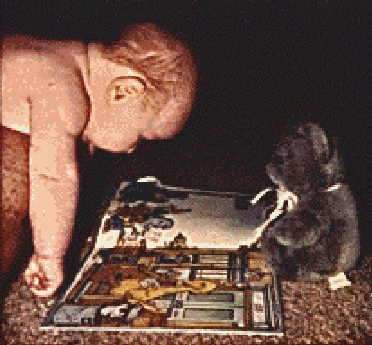
Even lines of black and white print provide an interesting pattern for the baby to look at.
- One of the advantages to having your baby on the floor a lot is that she will develop strength in her neck very rapidly and be able to investigate more patterns.
| 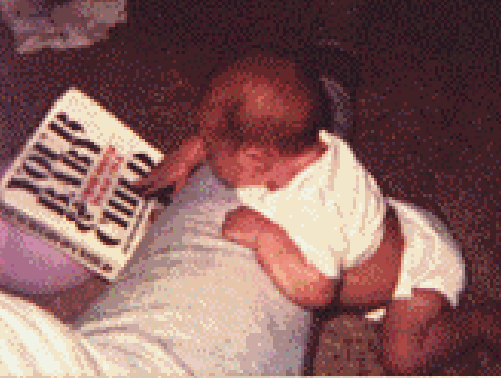
Pictures on many products provide excellent sources for patterns.
- I have also seen infants examine for long periods of time, as they were being changed, the baby faces on the packs of diapers.
| 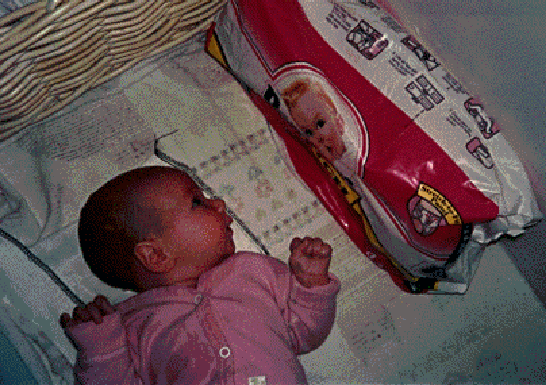
Toys for the crib provide excellent sources for visual pattern stimulation.
- While you can get along without them, mobiles and other objects in the crib do provide many minutes of stimulation, especially after baby is waking up from a nap.
| 
Many objects on the floor can provide excellent sources for visual pattern stimulation.
- Floor time is a good time for finding things to look at. This is home work for baby.

Relatives' faces can provide excellent additional sources for visual pattern stimulation.
- In my case, we had to use relative's faces because we didn't want to traumatize the child. But extended family, especially grandparents, are a wonderful source of devoted faces that baby can grow with.
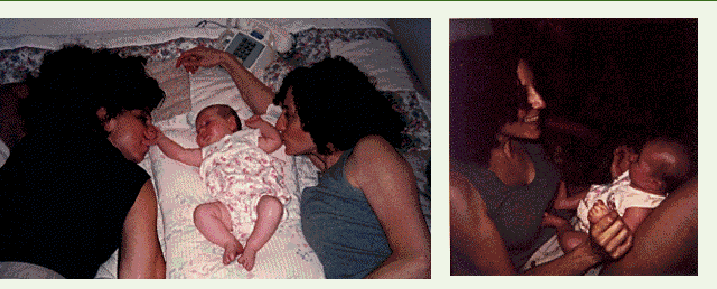
Patterns patterns everywhere if we have the time to look.
- And I have seen mothers going through the grocery store showing their infants various items and discussing each with them. I have also seen others look at them pityingly, obviously thinking they were nuts to carry on such conversations with an infant. But these are the conversations that brain tissue growth is made of! And these mothers are intuitively doing the right thing.
- There are a million household objects and inexpensive toys (soft rubber or cloth balls, blocks, dolls etc. which can be placed within the grasp and gaze of infants to stimulate them.
- Of course, the caretaker (mom/dad) must be attending closely, like a referee at a wrestling match, to see that they are within reach but are not a danger to the child.
Caring for an infant correctly is very physically draining, and mentally stressful with big rewards that are late in coming.
- This is not an expensive proposition, but it is intensive requiring considerable time and energy on the part of the caretaker (mom and/or dad). It is physically draining and mentally stressful.
- On a scale of 1 to 10, ten representing a dedication and commitment equivalent to a person running for the Presidency, I would rate it at an 10, if it is done right.
- It is why many misdirected men and women would rather "work" and hire a baby sitter or day care center to "watch" their kids than do it themselves.
- But babysitters and day care centers are businesses and hence, labor issues, not the child's development, are more often the first consideration.
- Notice how long it has taken me to say this...(sorry about that, but that's how I got this job). There are some moms with little formal education who intuitively knew it all along. My hat is off to them!
- If you possibly can arrange it, stay at home with your infant and pay a lot of attention to him/her. It will pay big dividends years down the line in terms of your child's cognitive and language development.
- 3. Depth Perception: If there is one process I could point to that provides a classic example of what perception is, it is Depth Perception. Consider what reality should be, if we go simply with what I happening at the level of the transducer.
- We have two eyes and receive two flat images which differ only slightly in the angle of their line of sight. Hence, what we should experience is two overlapping images that are slightly different (not to mention the upside down bit).
- But what appears in our consciousness is one image separated from other objects in a three dimensional space. Since, the transducers are providing information in two dimensions only, the illusion of three dimensions (3D) is purely a construct of our brains!
Depth perception is based on Stereopsis and Learned Cues.
- Here again, the brain is adding something that was not in the original stimulus. There are two contributors to this creative process: Stereopsis and Learned Cues.
- Stereopsis: This is the illusion of a third dimension in space created by the brain. The cues for the brain to perform this constructive process are the angles of the line of sight on an object.
- When that angle matches the line of sight from each eye the brain combines the two images into one and builds the illusion of 3D.
- When I was in the Air Force doing what they called photo intelligence, we had to look at photos taken from high above cities and try to describe what we were seeing. What we were seeing on the photo, by and large, were relatively meaningless patches of different shapes, sizes and shades.
Stereopsis is the brain's creation of a world in three dimensions from two flat images.
- But then they gave us two pictures of the same city, each taken by a different camera on the same plane.These had been positioned so that they emulated the angle of sight from two human eyes.
- Now when we looked at each picture with each eye separately, the brain created its 3D illusion from the two flat photographs. Some patches seemed to rise up to become easily recognizable as skyscrapers, while others were at ground level like parking lots.
- Note that it takes two functional and coordinated eyes to experience 3D. Also consider what happens when the stereopsis process is disturbed, by perhaps a blow to the head or two many beers. We see reality as the transducer portrays it--in double overlapping images; and our judgement of depth is diminished.
Learned cues are used by artists to portray depth on a two dimensional canvas.
- Learned Cues: Even if a person does not have binocular vision, distance can be perceived on the bases of learned cues.
- For example, we have learned that parallel lines, which never meet in geometry class, do come together in the distance. Just look down the railroad tracks (after the Amtrak has passed).
- This is a cue for distance which artists use to portray depth on a flat canvas.
- Degrees of shading, and the height of objects on our visual field are other distance cues.
- One cue that we don't often think of is called parallax. As you drive along a road, objects (like telephone poles) that are close to you move in the opposite direction faster than those that you might view in the distance. And of course, the moon never seems to move at all.
Depth Perception plays a role in the perceptual processes of Size and Shape constancy.
- Depth perception is important to the development of many worldly concepts to which language is associated; but it also interfaces with other perceptual processes, like size and shape constancy and spatial relations.
- 4. Size and Shape Constancy: If our perception of reality were left to the transducers alone, the world would be more like that in Alice in Wonderland. Alice, for example, experiences a time when people seem to grow and shrink.
- Ironically, that is exactly what happens when people or animals come towards or away from us. Their images swell or shrink on our retina. We are hardly aware of this, however, because our brain, in a perceptual process called Size Constancy, automatically provides a trade-off between distance and size.
- In cartoons, for example, when they want to portray an approaching car, they simply make it larger. We perceive it as not changing in size but rather as coming closer.
Without the perceptual process s of Size Constancy the world would be like Alice in Wonderland.
- When I look at the students in the rear of my on-campus class, I do not perceive them as being any smaller than those in the front row (even though they are much smaller on my retina). My brain preserves their size (makes them bigger) but places them far
- This perceptual finagling with size and distance can be seen in the illustration of the Theatre Scene on the next page.
- Line C-D, which is farther away (as judged by learned cues), appears perceptually to be larger than line A-B.
- In reality, as measured by a ruler, the lines are of equal length. The perceptual process however, modifies our experience, based on the distance/size trade off. There are also some more neat examples in the notes.
An example of Size Constancy.
Which line is bigger, A-B or C-D ?

Size and Shape constancy reduce the number of changes that must be decoded in our environment.
- It is believed that some schizophrenic children lack this perceptual process and do experience a frightening world in which people and animals swell and shrink before their very eyes.
- Size Constancy, in summary, reduces the factor of change in our perceived world and hence simplifies the perceptual process.
- Shape Constancy also contributes to this simplification, which if you remember, is a form of internally generated redundancy.
- Look at any tabletop and describe it. Usually we will call it rectangular. But is it really? It is rarely rectangular, as far as our retina is concerned.
- Depending on our angle of view (and there can a different one for each step we take around the table), there will be a different polygon shape portrayed on our retina, none of which will be a rectangle. Our brain, however, makes the necessary corrections for us and we perceive a rectangle.
Shape constancy provides redundancy in the reading process.
- Shape constancy is good for decoding worldly objects, although it wreaks havoc when we try to draw something, like a table. If we draw what we perceive (a rectangle), it simply doesn't look right. It takes someone with training in art to learn to ignore the percept and draw the retinal version of the tabletop.
- Shape constancy also helps us to recognize letters or words when they get twisted or turned.
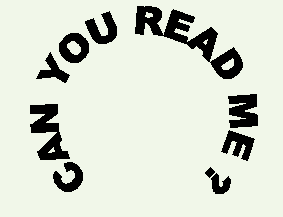
- This is tricky, though, because many of our letters take on a different meaning, depending upon their position in space.
- 5. Position in Space & Spatial Relations: Perhaps the most important perceptual process in today's symbolic world are those that tell us where we are in space.
- In my opinion, if I had to choose just one, I would say that the most precious commodity in the Universe is Space! It is mind boggling to hear that the universe is expanding, and beyond the reaches of that fringe of expansion is no space(?). I can't begin to understand that.
- But I do believe that we have a special need to know where we are in the space that we do have. What is up and down; what is in front and in back, what is to the right and to the left--we are very comfortable when we have this knowledge, which we usually do.
- But when we lose these references, it can be devastating. Think how John Kennedy must have felt when he was flying at dusk over water and found that he could not discern any features in his visual field.
Space is always a precious commodity.
- John Kennedy (son of President Kennedy) flying at dusk over water, from his plane could find no landmarks, nor even the horizon through the fading light and haze. He was in an opaque void in space where there was no up or down, right or left. I can understand how he must have become disoriented and crashed.
- Astronauts must undergo intense training to keep from becoming violently ill when they experience the weightlessness of outer space. There, the vestibular sense cannot find the gravity to establish an up or a down, and spatial relations yield to chaos bringing sensations of sickness.
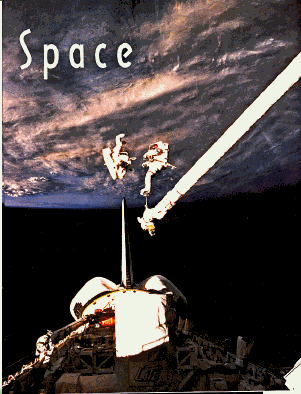
Our awareness of space can be diminished.
- The worse sickness I can think of is severe vertigo. Menier's Disease, for example, causes severe vertigo, and for anyone who has suffered it, the coordinates of space seem to disappear.
- How precious, then, is the neural infra structure in the vestibular, kinesthetic, tactile, visual and even the auditory modalities with all their perceptual processes that transduce, interpret and integrate the information so we can know where we are in space...and subsequently, where all other things are relative to us!
- As you can imagine, an infra structure as complex as this has much opportunity for a processes here or there to fail. The result is not a total chaos but diminished awareness of our coordinates.
- This may present no serous problem to us when coping with the real world, but when we enter the virtual world of symbols, serious difficulties can arise.
Position in Space is what is up and down and to our right and to our left.
- Take Position in Space for example. This is the ability to understand the position of an object in space relative to us as the Center of the Universe (the old Ptolemy concept still has some uses).
- In other words, we know what is up and down or to our right and left, or do we? In the graphic below, for example, determine which one is different?
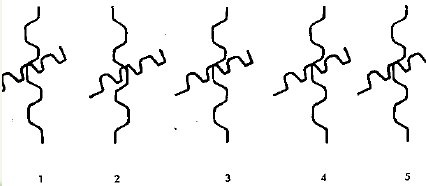
- It takes a minute to be sure doesn't it.
- To process this successfully, we must place ourselves in the axis position (center) and then determine the direction of the lines to the right or left of us. The answer, of course, to this little exercise is number...(look below please)
Position in Space is what is up and down and to our right and to our left.
- (continued from above)...number 2.
- Here is another one below, which includes both up and down coordinates. Can you tell which box in the top row is the same as the criteria box below. It is not too difficult for us to pick out number 5, but for a child with a spatial relations problems it could be very difficult. Paper tasks like these can be generated to provide non language training materials for older students.
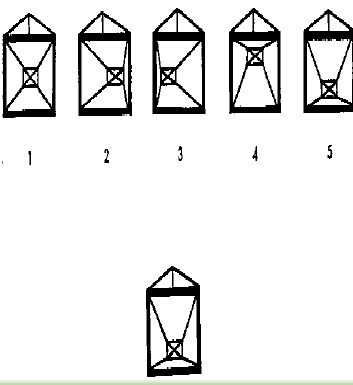
An awareness of Position in Space is important for recognizing letters.
- In particular, a strong awareness of position in space is critical to the visual decoding process for linguistic symbols.
- For example, how we interpret the following depends on how we perceive their position in space like...
- Can you imagine, if you had a diminished awareness of position in space, how difficult it would be to learn to recognize a word like "dad" that might look like "pad" or "bad" or "gad" or "bag" or "gag" or "gab" or many other possibilities.
- What a nightmare, and yet there are many children with just this problem who are trying to learn to read with minimal success and maximal frustration. Notice too, that taken alone, it's a problem in organization, (perception) and not retrieval (dyslexia)
An awareness of Spatial Relations is important for recognizing words.
- Spatial Relations, is similar to position in space, but slightly more complex. This is the ability to discriminate the position in space of things relative to other things as the center point in space. I may know that John is to my right but not be sure who is to his right or left.
- In the symbolic world, for a child with problems in Spatial Relations, words like "dab" and "bad" might look the same, even if he can distinguish the "d's" from the "b's".
- The development of Position in Space and Spatial Relations can be facilitated in young children by providing them with opportunities to play with objects, like blocks and puzzles dolls, tea sets etc, which can be manipulated in different orders.
- Simple group games are excellent too, in which children place themselves in various positions around other children. For example, the Nursery Rhyme, "Looby Loo" has kids moving together in a circle.
There are many activities which will improve Position in Space and Spatial relations.
- In "Looby Loo," the children practice putting in their left or right hands or feet towards the center of the circle. Other songs have the children circle each other and place themselves in various locations in front of, beside or behind someone else.
- Below is a typical example of a paper and pencil exercise in Spatial Relations. This task is to retrace the path shown un the upper picture in the one below.
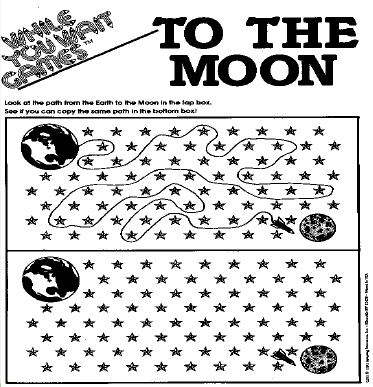
Pattern recognition depends on many variables.
- For older children, there are a myriad of workbooks available with many paper and pencil tasks (similar to the ones we have shown here) that will exercise these perceptual processes. They must be selected so that they will provide maximum opportunities for success, and so that they will progress in small steps from simpe to more complex tasks.
- 6. Pattern Recognition: We have talked about pattern preference, in which a child seeks patterns and processes them without recognition. But at what age do children begin to recognize things. Darned if I know!
- There are so many variables involved that it makes it difficult to make any meaningful generalization. For example, a definition of recognition depends upon many factors.
There is great variability in pattern recognition and drawing among children.
- Pattern recognition tasks can involve stimuli of varying degrees of concretness, complexity, and motivational value for the child. Other variables include the past experiences of the child, and the mode of response employed (eg. Pointing, drawing, etc.)
- Let me give a general, if not relatively meaningless, rule of thumb, that a child should be able to recognize and draw a Cross by the age of 2, a Circle by the age of 3, a Square by the age of 4 and a Triangle by the age of 5 years of age. Note, however. the picture below drawn by a 3.5 year old girl.
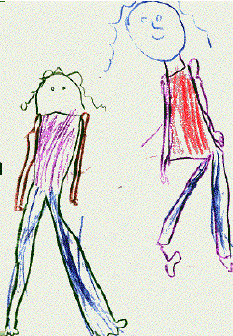
- This includes circles, rectangles and oblique lines (which you wouldn't expect until 5 yrs.)
Pattern recognition is dependent upon the culture of the child.
- The point here is that Pattern Recognition is highly influenced by experience and culture. It is very dependent upon experience and learning. Because of this you would not expect children from the Amazon or Borneo Jungles perform tasks like these until they were 8 or 9 years old, although they could recognize many other things we couldn't much earlier.
- In our society, children are born on rectangular tables in square (or round) rooms.
- They leave through rectangular doors to live in rectangular cribs. They eat off round plates, live on city blocks in houses with triangular roofs. These forms are very much a part of their world. Why wouldn't they learn to recognize them earlier.
- Even the symbolic letters, which will be such an important part of their future, are nothing but intricate combinations of bits and pieces of crosses, circles, squares and triangles.
Experiences are the key to the development of Pattern Recognition.
- Because Pattern Recognition is cultural, we know that the key is experiences.
- Considering the complexity of letters, their importance in our children's lives, and the need to recognize them relatively early (many school programs have reading programs for five and six year olds), it would seem to me that we would want to provide for our children as many experiences as we can to develop the neural infra structure to easily recognize these basic patters.
- This translates in to having many "things" available for children to explore and interact with as babies. Soft round cloth and rubber balls, blocks of various shapes and sizes, and many other objects that can be grasped, mouthed and manipulated are the tools that the child will use to build the perceptual skills to recognize patters.
- Allowing the child to explore and handle objects in the rooms of his house (versus sitting him many hours in a crib or play pen) is not an expensive proposition.
Toys are the child's tools for developing pattern recognition and the neural infra structure that supports this process.
- Warning--do try this in the home, but beware-- it takes intensive monitoring which is physically and mentally stressful for the moms and/or dads.
- When the child is older, we would like to see pencils, crayons and paints (and paper), and a place to use them readily available for the child to continue his perceptual exploration.
- It's called play but it's as important as college prep.
- The exercising of these perceptual skills not only fosters skills that are useful now, but they also represent, more importantly to me, an indication of increased neural growth.
- It is this growth that provides a rich neural infra structure that will assure the acquisition of related skills all throughout the child's life.
- Let's continue now to discuss some of the important auditory perceptual skills.
| | | | | | | | | |
| |